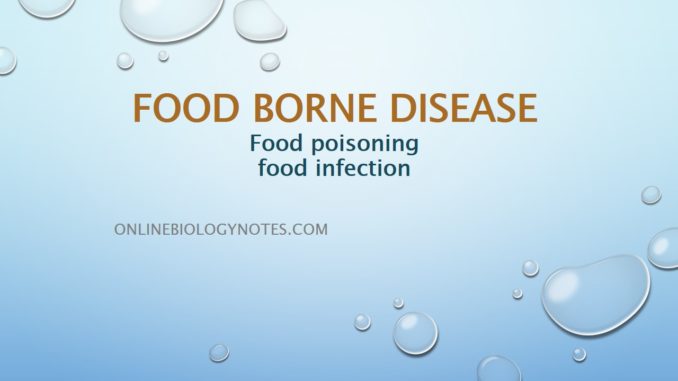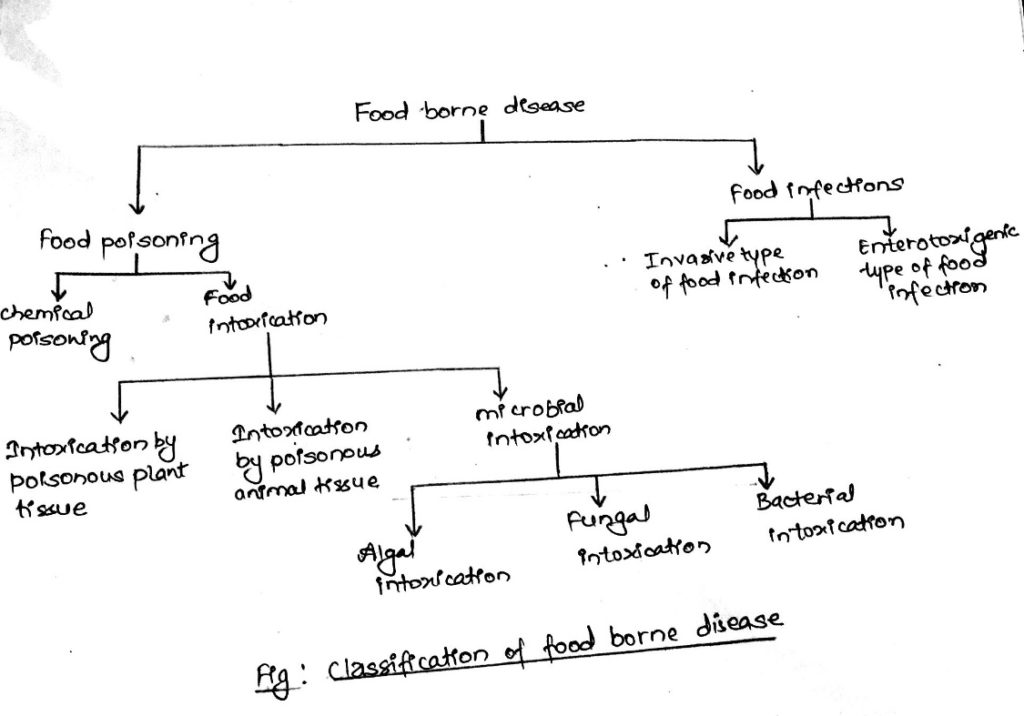
Concept of food borne disease:
- Food borne disease are divided into two main types i.e. poisoning and infection.
- Food poisoning:
- If disease is caused by infection of toxic chemical present in food, it is called food poisoning.
- Food poisoning is further divided into two types i.e. chemical poisoning and food intoxication.
- If poisoning is caused by injection of poison which is accidently or purposely added in food, it is called chemical poisoning. E.g. disease caused by injection of rat poison in food.
- If poisoning is caused by injection of toxin secreted by living being, it is called food intoxication.
- Sometimes tissue of food is itself toxic and causes intoxication. E.g. mushroom poisoning.
- Some microorganisms contaminate food and produce toxin in the food.
- If intoxication is caused by injection of microbial toxin in food, it is called microbial food intoxication.
- Food infection:
- If disease is caused by ingestion of viable microorganisms in food, it is called food infection.
- In food infection microorganisms multiplies in intestinal tracts and cause disease.
- There are two types of food infection i.e. invasive type and enterotoxigenic type.
- In enterotoxigenic type of food infection, microorganisms produce enterotoxin in intestinal tract that cause disease. E.g. food infection caused by EPEC, vibrio cholera.
- In invasive type of food infection microorganisms cause disease by invading through intestinal tract. E.g. food infection caused by Shigella, EIEC.
- In some food borne disease, food simply serves as carrier of microorganisms and microorganisms do not multiply in food. For e.g. in case of vibrio cholera, Corynebacterium diphtheria, Mycobacterium bovis.
- In other food borne diseases food serves as cultivation medium for growth of microorganisms and microorganisms multiply in food. E.g. EPEC, vibrio parahaemolyticus.

Difference between food infection and food intoxication:
| Food infection | Food intoxication |
| It is caused by ingestion of viable microorganisms in food. | It is caused by ingestion of pre-formed toxin in food. |
| In this case microorganisms multiplies inside the host. | Microorganisms do not multiply inside the host. |
| Microorganisms as well as its toxin may be responsible for disease production. | Microorganisms itself is not associated with disease production and disease is caused by its toxin. |
| E.g. includes: Salmonelosis, Shigellosis, gastroenteritis caused by vibrio spp., E. coli. | E.g. includes: disease caused by Clostridium botulinum, Staphylococcus aureus, etc. |
Food poisoning caused by Staphylococcus aureus (Staphylococcal food intoxication):
- Disease caused by Staphylococcus aureus is intoxication caused by ingestion of pre-formed enterotoxin in food.
- It is one of the most commonly occurring food borne disease.
Etiological agent:
- Staphylococcus aureus is gram positive cocci that occur in grape like cluster.
- Intoxication is caused by enterotoxin producing strain of S. aureus.
- Most enterotoxin producer are coagulase +ve, however, not all coagulase +ve Staphylococcus aureus produce enterotoxin.
- It can tolerate high concentration of salt 10-20% of NaCl and sugar (50-60%).
- It is nitrate tolerant and can grow in curing solution of meat.
- They are proteolytic but usually do not produce bad smell in food.
- Therefore, food spoilage caused by S. aureus is difficult to judge by its smell and appearance.
- Temperature range for growth and toxin production is (14-46)oC and minimum value of Aw for growth is 0.86.
- Maximum pH for growth in food is 8.
- Natural habitat of S. aureus is skin and upper respiratory tract of human being and other animal.
- From these sources, it contaminates in food.
Enterotoxin:
- Staphylococcus aureus produces six antigenic type of enterotoxins.
- They include A, B, C1, C2, D and E, of which, type A and D are more frequently associated with food intoxication.
- Condition that favor multiplication of S. aureus also favor toxin production.
- Toxin is produced at an appreciable rate at (15.6-46.1)oC and production is best at 40oC.
- Under best condition, sufficient amount of toxin appears in food within 4-6 hrs.
- At lower temperature, it takes very long time to produce enough enterotoxin in food.
- Therefore, poisoning by S. aureus can be prevented by adequate refrigeration during storage of food.
- An important characteristic of enterotoxin is that it is heat stable.
- Therefore, this enterotoxin is not easily damage by normal cooking of food.
- So, food poisoning by S. aureus, occur when food is not sufficiently heated just before eating.
Food involved:
- Creamed filled bakery product are more commonly associated with S. aureus food poisoning.
- However, many other food products like meat and meat products, milk and milk products, vegetable, egg containing products etc. are also found associated.
Pathogenesis of staphylococcal food intoxication
- Staphylococcal food poisoning is caused by ingestion of pre-formed toxin in food.
- Enterotoxin acts on intestine to induce vomiting and diarrhoea.
- Production of diarrhoea by enterotoxin is not clear.
- Enterotoxin binds to the wall of small-intestine, stomach and large intestine with high affinity and it causes inflammation and irritation of lining of stomach and intestine.
- Induction of vomiting by enterotoxin occurs due to stimulation of central nervous system.
- Enterotoxin binds to receptor of vomiting in intestine, which stimulates vomiting center in brain via vagus and sympathetic nerves.
Disease symptoms of staphylococcal food intoxication :
- Symptom of the disease vary with amount of enterotoxin ingested and the immunity of the host.
- Staphylococcal food poisoning is characterized by very short incubation period of 2 – 4 hrs.
- Most common symptoms include vomiting, diarrhea, retching (sound in stomach), abdominal cramp, nausea.
- In severe case blood and mucus may be seen in stool and vomits.
- Mortality rate is extremely low and the disease is usually self-limiting.
Treatment of staphylococcal food intoxication:
- Treatment of diarrhea include giving salt solution to counteract loss of water and electrolyte during diarrhea.
Prevention and control of staphylococcal food intoxication:
- Staphylococcal intoxication can be prevented by:
- Preventing contamination of food:
- Good personal hygiene of food handler is very important to prevent contamination because S. aureus enters into food from skin and upper respiratory tract of human being.
- Person who is carrier of S. aureus should not be allowed to handle food.
- Preventing growth and toxin production:
- Growth of S. aureus in food and toxin production can be prevented by adequate refrigeration of food, by lowering Aw value of food below 0.86, by adjusting pH at very low level etc.
- Enterotoxin of S. aureus is heat stable. Therefore, it can be damaged by sufficient heating the food before eating.
